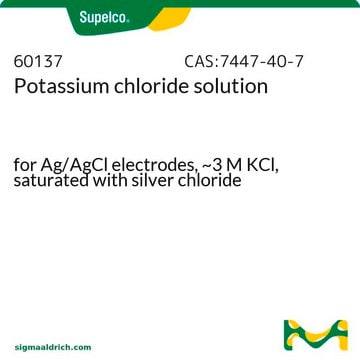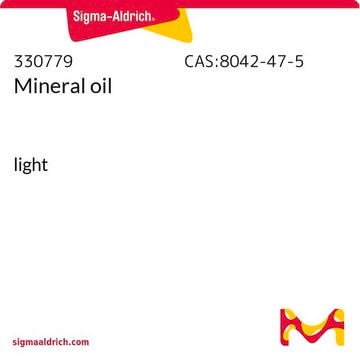62481
Lithium chloride solution
1 M in ethanol
Autenticatiper visualizzare i prezzi riservati alla tua organizzazione & contrattuali
About This Item
Formula condensata:
LiCl
Numero CAS:
Peso molecolare:
42.39
Numero MDL:
Codice UNSPSC:
26111700
ID PubChem:
NACRES:
NB.61
Prodotti consigliati
Grado
for analytical purposes
Livello qualitativo
Concentrazione
1 M in ethanol
Densità
0.83 g/mL at 20 °C
Stringa SMILE
[Li+].[Cl-]
InChI
1S/ClH.Li/h1H;/q;+1/p-1
KWGKDLIKAYFUFQ-UHFFFAOYSA-M
Cerchi prodotti simili? Visita Guida al confronto tra prodotti
Descrizione generale
Lithium chloride solution is generally used as a liquid desiccant for hybrid solar desiccant cooling systems. Though it is corrosive in nature, it does not vaporize in air at ambient conditions.
Applicazioni
Filling solution for reference electrodes used for titrations in nonaqueous solutions
Avvertenze
Danger
Indicazioni di pericolo
Consigli di prudenza
Classi di pericolo
Eye Irrit. 2 - Flam. Liq. 2
Codice della classe di stoccaggio
3 - Flammable liquids
Classe di pericolosità dell'acqua (WGK)
WGK 1
Punto d’infiammabilità (°F)
57.2 °F - closed cup
Punto d’infiammabilità (°C)
14 °C - closed cup
Dispositivi di protezione individuale
Eyeshields, Faceshields, Gloves, type ABEK (EN14387) respirator filter
Scegli una delle versioni più recenti:
Possiedi già questo prodotto?
I documenti relativi ai prodotti acquistati recentemente sono disponibili nell’Archivio dei documenti.
I clienti hanno visto anche
Study of an aqueous lithium chloride desiccant system: air dehumidification and desiccant regeneration
Fumo, Nelson, and D. Y. Goswami.
Solar Energy, 72 (4), 351-361 (2002)
Aitor González et al.
PloS one, 8(1), e53323-e53323 (2013-01-18)
The mouse segmentation is established from somites, which are iteratively induced every two hours from the presomitic mesoderm (PSM) by a system known as the segmentation clock. A crucial component of the segmentation clock is the gene Hes7, which is
Karla M Acevedo et al.
The Journal of biological chemistry, 289(16), 11007-11019 (2014-03-13)
Amyloid precursor protein (APP) undergoes post-translational modification, including O- and N-glycosylation, ubiquitination, and phosphorylation as it traffics through the secretory pathway. We have previously reported that copper promotes a change in the cellular localization of APP. We now report that
Na An et al.
Proceedings of the National Academy of Sciences of the United States of America, 111(40), 14325-14331 (2014-09-17)
Human telomeric DNA consists of tandem repeats of the sequence 5'-TTAGGG-3' that can fold into various G-quadruplexes, including the hybrid, basket, and propeller folds. In this report, we demonstrate use of the α-hemolysin ion channel to analyze these subtle topological
A Abu-Baker et al.
Cell death & disease, 4, e821-e821 (2013-10-05)
Expansion of polyalanine tracts causes at least nine inherited human diseases. Among these, a polyalanine tract expansion in the poly (A)-binding protein nuclear 1 (expPABPN1) causes oculopharyngeal muscular dystrophy (OPMD). So far, there is no treatment for OPMD patients. Developing
Il team dei nostri ricercatori vanta grande esperienza in tutte le aree della ricerca quali Life Science, scienza dei materiali, sintesi chimica, cromatografia, discipline analitiche, ecc..
Contatta l'Assistenza Tecnica.








